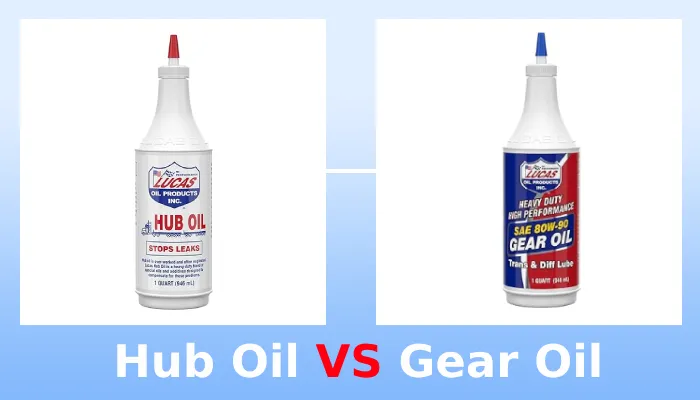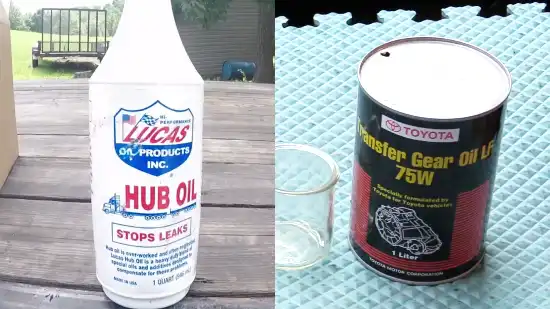Physical Address
304 North Cardinal St.
Dorchester Center, MA 02124
Physical Address
304 North Cardinal St.
Dorchester Center, MA 02124

Lubrication is fundamental to vehicle maintenance. This ensures that the various components of your vehicle are well-oiled to prolong its lifespan and provide optimum performance.
Hub oil and gear oil are two types of lubricants often used in vehicles. While both serve to reduce friction and protect components, they have distinct characteristics and applications.
Hub oil is specifically formulated for wheel hub assemblies such as wheel bearings and related components. While gear oil is used in various parts of the transmission system, it provides lubrication and protection to gears, gear bearings, and other transmission components.
We’re going to explain the differences between hub oil and gear oil and answer common questions throughout this article. So, keep reading the technical details and choose the suitable one.

When comparing hub oil and gear oil for vehicles, you must understand the major differences between them.
Hub oil is specifically designed for use in wheel hubs, where it protects wheel bearings and related components. Its thick and viscous nature is well-suited for high-load applications, such as wheel bearings, that experience extreme pressure and high temperatures.
Conversely, gear oil is formulated for use in manual transmission gearboxes, differentials, and transfer cases. Its primary function is to provide lubrication and protection to these systems’ gears, bearings, and other components.
Gear oil has varying viscosities, denoted by ratings of SAE (Society of Automotive Engineers). These ratings indicate the thickness of the oil, with higher SAE values like 70w-90 indicating thicker oil.
Meanwhile, Hub oil is specifically formulated to have a thicker and more viscous consistency. This is because hub oil needs to withstand the immense loads experienced by wheel bearings. The high viscosity of oil helps to provide effective lubrication and reduce friction between the moving parts of the wheel bearings.
Hub oil has additives that excel in extreme pressure conditions and high temperatures. These additives provide superior lubrication and protection to the hub assembly. Its additives typically include anti-wear agents, extreme pressure additives, and corrosion inhibitors.
On the other hand, gear oil incorporates additives specifically designed to combat wear, scuffing, and corrosion in high-speed, high-pressure gear applications. These additives often include anti-wear agents, friction modifiers, rust inhibitors, and detergents.
Hub oil, specifically for wheel hubs, is designed to handle extreme heat generated in heavy-duty towing applications. It offers superior thermal stability, allowing it to withstand the intense temperatures generated within the wheel hubs.
In contrast, gear oil, while also needing to handle heat from gears and bearings, may not require the same extreme temperature tolerance as hub oil. This difference is due to the variations in the operating conditions and specific requirements of these two types of oils.
Gear oil needs to have good flow characteristics to circulate within the transmission or differential and effectively lubricate gears and bearings. It has a lower viscosity than hub oil, enabling it to flow more easily and reach all the necessary components.
On the other hand, Hub oil is designed to stay in place and resist flow, ensuring proper lubrication of wheel bearings even under heavy loads. Its viscosity is typically higher than gear oil, allowing it to provide sufficient lubrication at low speeds and temperatures.
Hub oil is designed to work effectively with wheel seals, ensuring that there are no leakages and providing long-lasting performance.
The formulation of hub oil typically includes additives that enhance its sealing properties, such as anti-wear agents and corrosion inhibitors. These additives help to create a tight seal between the hub and the wheel, preventing any lubricant from escaping.
As opposed to this, gear oil formulations are specifically tailored to work well with the seals found in transmission and differential applications. They’re designed to minimize the risk of leaks by providing excellent sealing properties under high pressure and temperature conditions.
The frequency of hub oil changes depends on factors including driving habits and manufacturer recommendations. Changing the hub oil as low as 3000 miles (4828 kilometers) or once a year is generally recommended.
Conversely, gear oil changes should be done according to the owner’s manual. For manual transmissions, the recommended range is typically between 80,000 to 140,000 kilometers. For automatic transmissions, the range is usually between 60,000 to 120,000 kilometers.
Hub oil is specifically designed for vehicle wheel bearings, requiring a lubricant that can withstand high temperatures and heavy loads. This specialized formulation increases the production costs of hub oil, resulting in a higher price point for consumers.
Additionally, gear oil is used in various components of the vehicle’s transmission and differential, and it’s available in a range of viscosities to suit different gear systems. The wider applications and simpler gear oil formulation contribute to its lower cost than hub oil.
Here’s a comparison table summarizing the key differences between hub oil and gear oil for vehicles:
| Aspect | Hub Oil | Gear Oil |
| Primary Application | Wheel hubs and bearings | Transmissions, differentials, gears |
| Viscosity | Thick and viscous | Varies, but often thicker than engine oil |
| Additive Packages | Specialized additives for high-loads | Additives for wear, scuffing, and corrosion |
| Cost | Typically more expensive | Generally more cost-effective |
| Frequency of Oil Changes | 3000 miles or once a year | Typically 80k-140k km for manual, 60k-120k km for automatic |
| Temperature Tolerance | High-temperature resistance | Good thermal stability |
| Flow Characteristics | Resists flow | Should have good flow properties |
| Gear Oil Variety | Specialized and fewer variations | Wider range of viscosities and formulations |

Thicker gear oil shouldn’t be used in vehicle hubs, as it isn’t suitable for the purpose and can lead to damage. The viscosity of hub oil is higher than that of gear oil, which allows it to provide lubrication and protection to the bearings under heavy loads and high temperatures.
Thicker gear oil, if used in vehicle hubs, can result in inadequate lubrication, leading to increased friction and wear on the bearings. This can eventually cause premature failure of the bearings, resulting in costly repairs and potential safety hazards.
Using hub oil in your vehicle’s transmission box isn’t recommended.
Hub oils are specifically formulated in hubs and bearings with different viscosity. These oils are typically thicker and have a higher flow resistance, which is necessary to provide adequate lubrication and protection to the hub components.
However, these properties make hub oils unsuitable for transmission applications. Transmissions require a specific viscosity and different additives to ensure proper lubrication, cooling, and protection of gears, bearings, and other internal components.
Gear oil is suitable for manual transmissions. While automatic transmissions typically use automatic transmission fluid (ATF), gear oil can also be used in certain automatic transmissions. However, note that not all automatic transmissions can use gear oil.
Gear oil is designed to withstand the high pressures and extreme temperatures in manual transmissions. It has a higher viscosity and better lubricating properties compared to ATF. This makes it suitable for the harsher operating conditions of manual transmissions.
Hub oil and gear oil are distinct in viscosity, application, and purpose. Using the right type of oil for the intended component is crucial for ensuring your vehicle’s longevity and proper functioning.
While thicker gear oil may not be suitable for vehicle hubs, hub oil shouldn’t be used in the transmission box. Moreover, manual transmissions are compatible with gear oil, and automatic transmissions are compatible with transmission fluid.
Considering these distinctions, you can ensure the optimal performance and longevity of your vehicle’s essential components.
Last update on 2025-12-18 / Affiliate links / Images from Amazon Product Advertising API